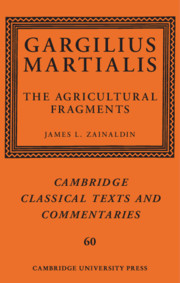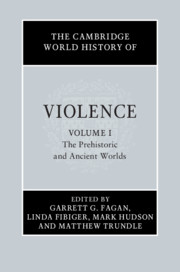Refine search
Actions for selected content:
23990 results in Ancient history
22 - Ritual Killing and Human Sacrifice in the Ancient Near East
- from Part IV - Religion, Ritual and Violence
-
-
- Book:
- The Cambridge World History of Violence
- Published online:
- 13 March 2020
- Print publication:
- 26 March 2020, pp 460-474
-
- Chapter
- Export citation
13 - Violence and Warfare in Early Imperial China
- from Part II - Prehistoric and Ancient Warfare
-
-
- Book:
- The Cambridge World History of Violence
- Published online:
- 13 March 2020
- Print publication:
- 26 March 2020, pp 277-296
-
- Chapter
- Export citation
11 - Violence and the Roman Way of Warfare
- from Part II - Prehistoric and Ancient Warfare
-
-
- Book:
- The Cambridge World History of Violence
- Published online:
- 13 March 2020
- Print publication:
- 26 March 2020, pp 238-256
-
- Chapter
- Export citation
Index
-
- Book:
- The Cambridge World History of Violence
- Published online:
- 13 March 2020
- Print publication:
- 26 March 2020, pp 704-740
-
- Chapter
- Export citation

Herodotus in the Long Nineteenth Century
-
- Published online:
- 13 March 2020
- Print publication:
- 26 March 2020

Gargilius Martialis: The Agricultural Fragments
-
- Published online:
- 13 March 2020
- Print publication:
- 02 April 2020

The Cambridge World History of Violence
-
- Published online:
- 13 March 2020
- Print publication:
- 26 March 2020
Inventory A2 352/1–322/1
-
- Book:
- Decrees of Fourth-Century Athens (403/2-322/1 BC)
- Published online:
- 18 February 2020
- Print publication:
- 05 March 2020, pp 397-831
-
- Chapter
- Export citation
Inventory B Checklist
-
- Book:
- Decrees of Fourth-Century Athens (403/2-322/1 BC)
- Published online:
- 18 February 2020
- Print publication:
- 05 March 2020, pp 832-836
-
- Chapter
- Export citation
Inventory B1 Testimonia that can be identified as Probable Decrees (DP)
-
- Book:
- Decrees of Fourth-Century Athens (403/2-322/1 BC)
- Published online:
- 18 February 2020
- Print publication:
- 05 March 2020, pp 837-951
-
- Chapter
- Export citation
Checklist by Genre-Type
-
- Book:
- Decrees of Fourth-Century Athens (403/2-322/1 BC)
- Published online:
- 18 February 2020
- Print publication:
- 05 March 2020, pp 39-44
-
- Chapter
- Export citation
Chapter 4 - Mani’s Death
-
- Book:
- The Founder of Manichaeism
- Published online:
- 16 January 2020
- Print publication:
- 05 March 2020, pp 59-82
-
- Chapter
- Export citation
Index locorum Pertaining to Decree Testimonia
-
- Book:
- Decrees of Fourth-Century Athens (403/2-322/1 BC)
- Published online:
- 18 February 2020
- Print publication:
- 05 March 2020, pp 977-983
-
- Chapter
- Export citation
Introduction
-
- Book:
- Decrees of Fourth-Century Athens (403/2-322/1 BC)
- Published online:
- 18 February 2020
- Print publication:
- 05 March 2020, pp 1-16
-
- Chapter
- Export citation
2 - Appropriation and Aspiration: Decrees in the Pursuit of Political Self-Interest
-
- Book:
- Decrees of Fourth-Century Athens (403/2–322/1 BC)
- Published online:
- 18 February 2020
- Print publication:
- 05 March 2020, pp 59-108
-
- Chapter
- Export citation
5 - Literary Representations of Athenian Decrees
-
- Book:
- Decrees of Fourth-Century Athens (403/2–322/1 BC)
- Published online:
- 18 February 2020
- Print publication:
- 05 March 2020, pp 189-239
-
- Chapter
- Export citation
Appendix 1 - Proposers of Decrees at the Athenian Assembly 403/2–322/1
-
- Book:
- Decrees of Fourth-Century Athens (403/2–322/1 BC)
- Published online:
- 18 February 2020
- Print publication:
- 05 March 2020, pp 247-268
-
- Chapter
- Export citation
Contents
-
- Book:
- Decrees of Fourth-Century Athens (403/2-322/1 BC)
- Published online:
- 18 February 2020
- Print publication:
- 05 March 2020, pp v-v
-
- Chapter
- Export citation
Conclusion
-
- Book:
- Decrees of Fourth-Century Athens (403/2–322/1 BC)
- Published online:
- 18 February 2020
- Print publication:
- 05 March 2020, pp 240-246
-
- Chapter
- Export citation
Introduction Bibliography
-
- Book:
- Decrees of Fourth-Century Athens (403/2-322/1 BC)
- Published online:
- 18 February 2020
- Print publication:
- 05 March 2020, pp 45-46
-
- Chapter
- Export citation
